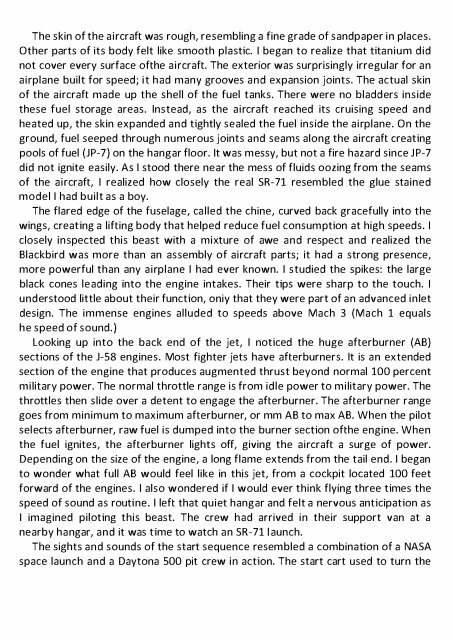You also want an ePaper? Increase the reach of your titles
YUMPU automatically turns print PDFs into web optimized ePapers that Google loves.
The skin of the aircraft was rough, resembling a fine grade of sandpaper in places.<br />
Other parts of its body felt like smooth plastic. I began to realize that titanium did<br />
not cover every surface ofthe aircraft. The exterior was surprisingly irregular for an<br />
airplane built for speed; it had many grooves and expansion joints. The actual skin<br />
of the aircraft made up the shell of the fuel tanks. There were no bladders inside<br />
these fuel storage areas. Instead, as the aircraft reached its cruising speed and<br />
heated up, the skin expanded and tightly sealed the fuel inside the airplane. On the<br />
ground, fuel seeped through numerous joints and seams along the aircraft creating<br />
pools of fuel (J P-7) on the hangar floor. It was messy, but not a fire hazard since J P-7<br />
did not ignite easily. As I stood there near the mess of fluids oozing from the seams<br />
of the aircraft, I realized how closely the real SR-71 resembled the glue stained<br />
model I had built as a boy.<br />
The flared edge of the fuselage, called the chine, curved back gracefully into the<br />
wings, creating a lifting body that helped reduce fuel consumption at high speeds. I<br />
closely inspected this beast with a mixture of awe and respect and realized the<br />
Blackbird was more than an assembly of aircraft parts; it had a strong presence,<br />
more powerful than any airplane I had ever known. I studied the spikes: the large<br />
black cones leading into the engine intakes. Their tips were sharp to the touch. I<br />
understood little about their function, oniy that they were part of an advanced inlet<br />
design. The immense engines alluded to speeds above Mach 3 (Mach 1 equals<br />
he speed of sound.)<br />
Looking up into the back end of the jet, I noticed the huge afterburner (AB)<br />
sections of the J-58 engines. Most fighter jets have afterburners. It is an extended<br />
section of the engine that produces augmented thrust beyond normal 100 percent<br />
military power. The normal throttle range is from idle power to military power. The<br />
throttles then slide over a detent to engage the afterburner. The afterburner range<br />
goes from minimum to maximum afterburner, or mm AB to max AB. When the pilot<br />
selects afterburner, raw fuel is dumped into the burner section ofthe engine. When<br />
the fuel ignites, the afterburner lights off, giving the aircraft a surge of power.<br />
Depending on the size of the engine, a long flame extends from the tail end. I began<br />
to wonder what full AB would feel like in this jet, from a cockpit located 100 feet<br />
forward of the engines. I also wondered if I would ever think flying three times the<br />
speed of sound as routine. I left that quiet hangar and felt a nervous anticipation as<br />
I imagined piloting this beast. The crew had arrived in their support van at a<br />
nearby hangar, and it was time to watch an SR-71 1aunch.<br />
The sights and sounds of the start sequence resembled a combination of a NASA<br />
space launch and a Daytona 500 pit crew in action. The start cart used to turn the


